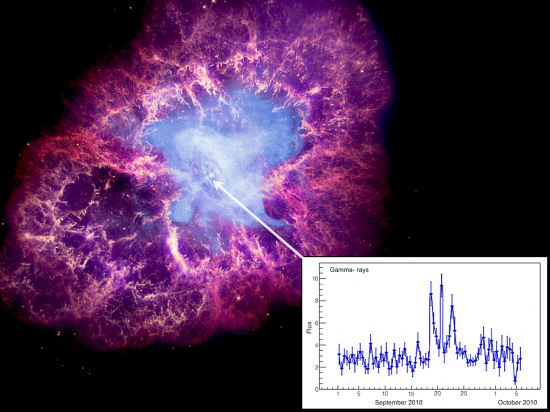Oct 1, 2014
Pulsars are more like oscillating circuits.
On July 4, 1054 CE, Chinese astrologers saw a “guest star” near Zeta Tauri in the constellation Taurus. They record that it was bright enough to shine in daylight, but lasted only about a year before fading out. John Bevis saw a bright nebula in the reported location in 1731, while Charles Messier recorded his observation in 1758. William Parsons, the third Earl of Rosse, using a 72-inch, four ton metal mirror telescope called “the Leviathan of Parsonstown,” wrote that the nebula resembled a crab’s claw, so it came to be called the Crab Nebula.
Consensus opinions state that the nebula is the remains of a supernova explosion. What is normally called a pulsar was initially discovered in the center of the Crab Nebula by radio astronomers in 1968. Subsequently, it was found to be an optical and X-ray radiation source, as well. The Crab Nebula pulsar blinks at 30 times per second, so by definition, the central star “must be” rotating at 30 times per second.
In the image at the top of the page, electrons accelerated at high energies are shown in blue, with lower energy electrons in purple. Fermi satellite data (inset) recorded the the highest energy electrons near the center of the nebula: the most energetic ever detected.
Neutron stars are supposed to answer the question of anomalous pulsar behavior, especially when their brightness fluctuates over a short time, like the Crab Nebula pulsar. They are thought to be the leftovers after stars “blow off” their outer layers in powerful explosions, leaving a super-dense core behind. All the electrons in the remaining stellar core are said to be gravitationally compressed until they combine with protons in the nuclei, forming matter so dense that a single teaspoon would weigh billions of tons on Earth.
Pulsars are thought to form when a neutron star’s magnetic field exceeds 10^15 Gauss. In comparison, Earth’s magnetic field measures one-half Gauss. The evidence for neutron stars is indirect, however, and none have ever been observed. What is observed are intense magnetic fields pulsing in fractions of a second. Electric Star theory proposes that neutron stars are imaginary objects. A gravity-only cosmology requires them because the forces generated from spinning billions of megatons as fast as a power drill would cause the star to tear itself apart.
One of the most difficult problems associated with neutron stars is that they violate the “Island of stability” principal. The number of neutrons plotted against the number of protons in elemental nuclei reveals a ratio of about one-to-one for light elements and one point five-to-one for heavier ones. Anything outside that range will spontaneously decay until it reaches equilibrium. Too few neutrons and atoms will emit protons until they stabilize or vise-versa. Therefore, an atomic nucleus consisting of neutrons alone would be unstable and immediately decay.
Since magnetic fields are induced by electric currents, there must be electricity generating the intense fields in a pulsar. Those “feeder currents” must also be part of a circuit, since persistent electric current must flow in a completed circuit. Electric Universe advocates speculate that the oscillations in pulsars are caused by resonant effects in those circuits. The sudden release of stored electrical energy in a “double layer” is responsible for their energetic outbursts.
As electric charge flows through clouds of dusty plasma, the Biot-Savart effect draws linear filaments together, forming zones of compression known as “z-pinches” or “Bennett pinches.” Depending on how much electricity is flowing through the circuit, the star’s magnetic field will be greatest where the current density is at a maximum. It seems more likely that pulsars are exhibiting an immense accumulation of electricity focused by a “plasma gun” effect.
Super-dense matter and extreme rotation are unnecessary. Electricity flowing in circuits provides a coherent explanation for pulsar behavior, including gamma ray flares, that agrees with accepted electromagnetic theories.
Stephen Smith













